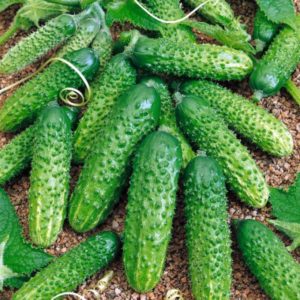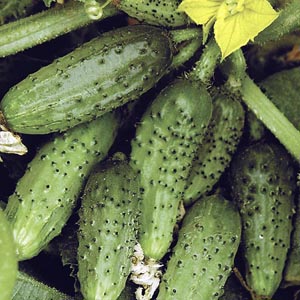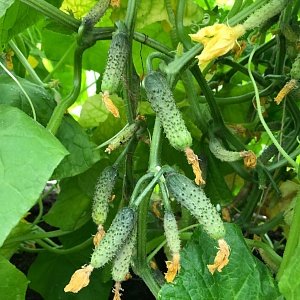What are the names of small cucumbers and which varieties of this type are the best
Small cucumbers are crispy and juicy. They are used to prepare winter blanks, which are especially popular all over the world. Many people mistakenly assume that small cucumbers are underdeveloped large fruits.
In the article, we will find out if this is so, and find out what the small cucumbers are actually called.
The content of the article
What are the small cucumbers called

Miniature cucumbers are called gherkins. The average length of one cucumber is 5-7 cm. Gherkins are used for making salads and snacks.
They are grown in a vegetable garden or in a garden, observing the basic agrotechnical rules: they water, fertilize and loosen the beds.
Origin story
The name "gherkin" came to Russia from France. The first mentions of gherkins date back to the 19th century. At that time, cucumbers began to be called "gherkins" - they were used to prepare assorted vegetables.
Later, all cucumber varieties with small fruits began to be called gherkins.
The best varieties of small cucumbers
Below we will tell you about the best varieties and hybrids of gherkins, learn the rules of growing and the secrets of a rich harvest.
Child f1
The hybrid is resistant to basic diseases of culture: root rot and tobacco mosaic. A vegetable is grown not only in the garden, but also on the windowsill or balcony. It is recommended to plant the nursery in a seedling way to avoid diseases.
Fruit size varies from 4 to 10 cm, weight is about 50 g. There are small pimples on the surface. The dense peel and crispy flesh are suitable for preparing various dishes: pickles, sauerkraut, pickled salads.
Prima donna f1
An early ripe hybrid ripens 35-45 days after the first shoots appear. The length of the cucumbers is from 10 to 12 cm, the average weight is 100 g. The surface is ribbed, cylindrical in shape, rounded to the tip. The pulp is pleasant, sweetish, no bitterness. Productivity is stable, summer residents collect about 15-20 cucumbers from 1 bush. Gardeners appreciate the hybrid for amicable fruiting and marketable qualities.
Important! Thanks to the dense skin, the prima donna gherkins are excellently transported over long distances and retain their taste and appearance.
Parisian gherkin
This famous variety gherkins refers to the early maturing - the harvest is harvested 40 days after the appearance of the first shoots. The Parisian gherkin is planted in the garden or in the greenhouse. The vegetable is resistant to high humidity and sudden changes in temperature. The length of the cucumber is about 6 cm, weight is 40-60 g. The taste is juicy, the surface is ribbed.
The variety is universal in use, cucumbers are consumed both fresh and canned.
Son of the f1 regiment
The maximum length of a cucumber is about 8 cm. The shape is round, the peel is covered with white pimples. The pulp is fleshy, there are many seeds, the taste is pleasant. The hybrid is appreciated for its unpretentious care, stable fruiting and versatility.
It is recommended to plant this gherkin for novice gardeners: caring for a vegetable does not require special agrotechnical skills.
Moth f1
Medium early Moth is harvested 50 days after planting. The hybrid has decorative, compact bushes. The vegetables themselves grow firm and crisp, the length of the gherkin is no more than 8 cm. The moth is suitable for preparing winter snacks - the vegetable does not lose its elasticity and retains its benefits.
Important! The gherkins contain potassium, which is necessary for the normal functioning of the kidneys and the cardiovascular system. The use of gherkins removes excess fluid from the body and serves as a prevention of problems with the thyroid gland.
Puccini f1
The cucumbers are oblong; there are many small thorns on the surface. The color is classic green, the pulp is sweet and juicy. At a time, 10 to 15 fruits are removed from the bush. The length of the vegetable is about 7 cm, weight is 40-70 g.
The Puccini hybrid rarely gets sick and is not exposed insect pests. Possesses good keeping quality and transportability.
Toddler f1
Grow gherkin outdoors or in greenhouses... They are planted with seedlings, having previously disinfected the seeds. Fruits are dense, uniform color, rich green. The hybrid is characterized by a friendly fruit set and long-term fruiting. The taste is gentle, the purpose of the hybrid is universal.
The toddler is resistant to cucumber mosaic and bacteriosis.
Thumbelina f1
The average length of a cucumber is 8 cm. The pulp is light green, there are many seeds. The taste is pleasant, the sweetness is moderate. The rind is thin so it is recommended to consume or process the crop within one to two weeks. Thumbelina is grown on the balcony or on warm and sunny beds.
How to choose a variety of gherkins for greenhouses

Gherkins are planted in greenhouses by gardeners from Siberia and the Urals... In these regions, there are frequent winds and rains, abrupt weather changes, cool summers. Cucumbers need protection, so they are planted in polycarbonate or glass greenhouses, as well as in small greenhouses.
The best varieties for greenhouses - Prima Donna, Moth and Son of the Regiment... Before planting, the walls and doors of the greenhouse are wiped with a solution of potassium permanganate, the earth is dug up and cleaned of debris.
For open ground
In the open field, hybrids Detsky, Karapuz and Puccini take root. These gherkins are cold-resistant and rarely get sick. They are not afraid of frost and torrential rains.
In open ground, gherkins are planted after herbs, legumes, carrots or cabbage. The beds should be loose and nutritious, with neutral acidity.
Growing features
Gherkins require more attention in care than ordinary cucumbers.
Features of growing gherkins:
- In hot and dry summers, cucumbers are watered every day. Warm and clean water is used for irrigation. It is not the stem and leaves that moisten, but the root.

- The plantings are kept clean - they regularly weed the beds and remove weeds. The soil is loosened every 7 days.
- Gherkins are fertilized with mineral and organic fertilizers. Ammonium nitrate, nitrogen, superphosphate, liquid manure and mullein are added.
- A layer of mulch is regularly organized around the stem - sawdust, river sand, ash, foliage are used. The mulch protects from the cold and nourishes the roots.
- For protection against pests, the preparations "Champion", "Decis" or "Kurzat" are used.
- For prevention diseases use spraying with Bordeaux liquid, copper sulfate solution, Kuprostat preparation.
- Gherkins have not been grown on the same plot for more than two years in a row.
- Recommended landing pattern 60x40. A thickened planting leads to the development of diseases and the appearance of pests.
- In cloudy weather, the beds are not moistened, in hot weather they are watered early in the morning or in the evening.
How to choose small cucumbers when buying
Gherkins should be elastic and dense, lethargy is a sign of spoilage of cucumbers. The color of ripe gherkins is uniform, without spots. The surface is bumpy, slightly prickly.
The gherkins should not be too long, the maximum size is 10 cm. If the cucumbers are purchased on the market, then make sure that they do not lie on the ground - this can lead to quick spoilage of vegetables.
How can you apply
Use whole gherkins or cut them into small pieces. The vegetable adds a pleasant sourness to dishes, makes the taste more juicy and piquant.
Gherkins are found in the following dishes:
- hodgepodge;
- tartar sauce;
- liver cake;
- Olivier salad;
- pickle;
- roast beef;
- pizza.
The most common way to use gherkins is to cook homemade pickles for the winter. Appetizing cucumbers are placed entirely in jars and look appetizing. Cherry tomatoes, carrots, onions, garlic, herbs and spices are added to the blanks. Such pickles will be a harmonious addition to boiled potatoes, soups and side dishes.
Conclusion
Any gardener can grow gherkins. The main thing is to choose the right variety and know the secrets of care. For cool regions, stable hybrids are suitable - Puccini or Children's, for southern lands - the Parisian gherkin.
Vegetables are harvested on average 40-50 days after the first shoots appear. They turn green, crispy and aromatic. Gherkins are used for making salads and snacks, soups and sauces.